Affiliate links on Android Authority may earn us a commission. Learn more.
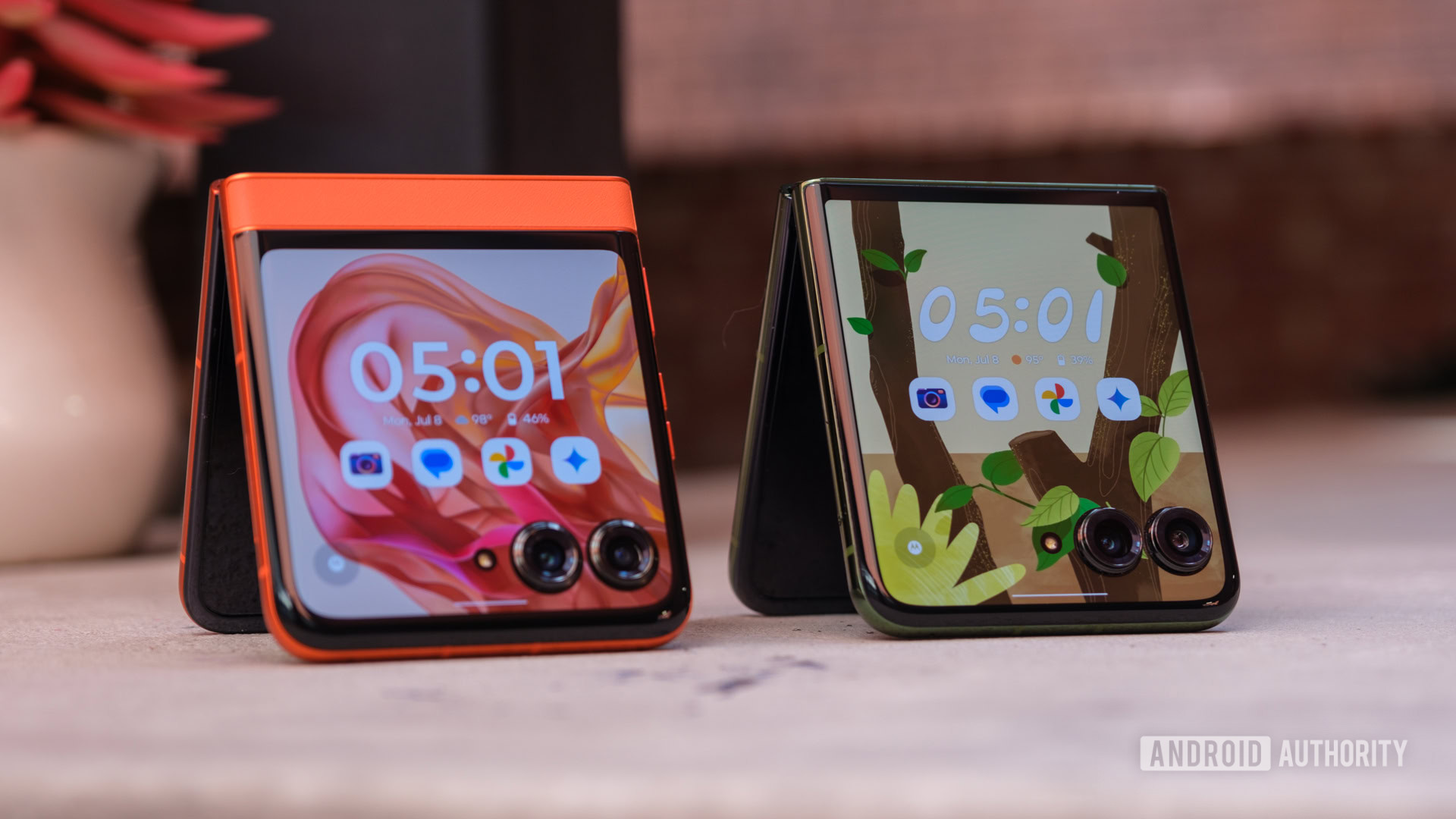

I still love Motorola's Razr Plus, but the cheaper Razr (2024) has won me over
Published onJanuary 6, 2025

Motorola Razr (2024)
MSRP: $699.99
What we like
What we don't like

Motorola Razr (2024)
Motorola created my favorite flip-style foldable phone to date when it introduced the Razr Plus in 2023. Not because there was anything earth-shatteringly wrong with Samsung’s previous Galaxy Z Flips or even Motorola’s older Razrs, but because the Razr Plus made its cover screen feel like a feature rather than an extra. It became possible to trust a 3.6-inch display for everything I needed throughout the day and trust it I did. Sure, there were flaws with the $1,000 flip phone, but the overall experience was good enough to make me look forward to the next time I could say “Hello, Moto” to something other than a cheap Moto G device.
Now that time has come, I’m torn — in a good way. The Motorola Razr Plus (2024) has arrived, and it’s a great phone, but I find myself falling harder for the more affordable Motorola Razr (2024). Here’s why I feel that way and whether or not my feelings are strong enough for me to close the Razr Plus for the year.
Cover (screen) me up
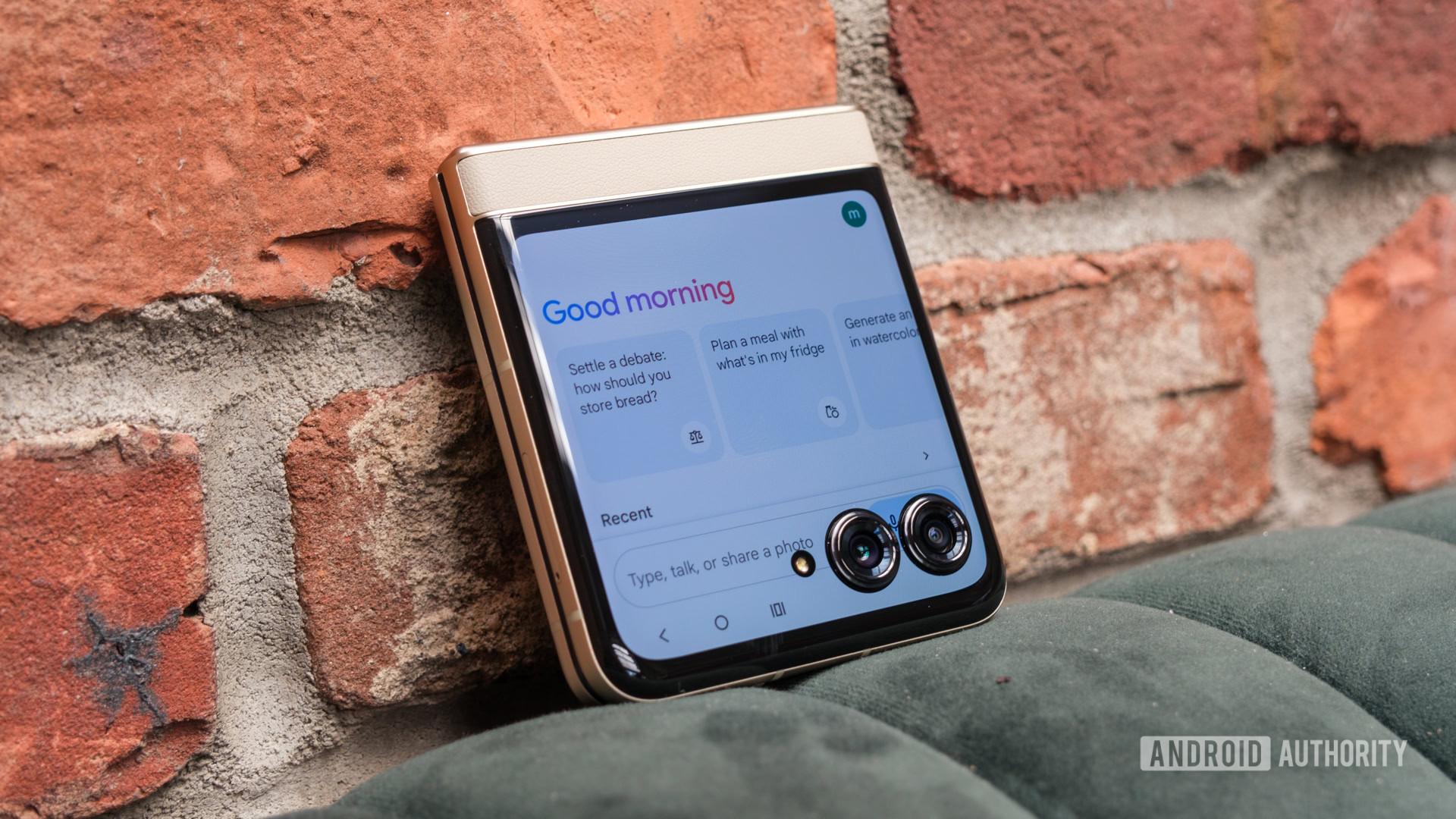
Last year, the larger cover screen was one of the main reasons I loved the Razr Plus. For the 2024 models, it’s a case of extra real estate all around, and it works heavily in the base Razr’s favor. While the more premium Razr Plus picked up a slightly larger external display, rising from 3.6 to an even four inches, the more affordable model more than doubled its size, jumping from 1.5 inches to 3.6 — nearly picking up the same panel I enjoyed on the previous generation.
However, I think some differences between the two benefit the newer Razr. For starters, Motorola dropped the refresh rate from 144Hz down to 90Hz, which still feels fast on a small, square display — not to mention being gentler on the battery life. It’s not all about downgrades, though, as the new panel is much brighter than before, topping out at 1,700 nits of peak brightness instead of 1,100. The change makes the Razr (2024) much easier to see in bright daylight than the Razr Plus (2023), and that’s without considering the new Razr Plus (2024), which has a variable 165Hz refresh rate and blinding 2,400 nits of peak brightness — both of which are impressive but might be overkill on a 4-inch display.
The Razr Plus has an incredibly powerful cover screen, but the Razr's specs make much more sense for a 3.6-inch panel.
Surprisingly, I also prefer the Razr’s (2024) smaller display from a safety perspective. Although both models use similar panels of Gorilla Glass Victus, the protective strip of vegan leather near the base Razr’s hinge helps me believe it would be a bit safer should it tumble out of my hand. The soft textured panel gives me a place to grab the Razr without smearing fingerprints over the external display, which is always welcome.
Of course, just as important as the size and specs of the new cover screen is how Motorola chooses to use it. If you experienced the Razr (2023), you probably remember that its cover display wasn’t good for much beyond simply checking your notifications and offering a tiny camera preview, while the Razr Plus offered all the bells and whistles like opening apps and playing games. Now, both Razrs are created equal — down to the last widget and game.
Even better than that, Motorola has improved some of the best widgets from the previous Razr Plus, including revamping Spotify. Previously, the cover screen streaming experience offered little more than basic controls and a few of your most recent playlists to jump back into. Now, Spotify can stretch further across the cover screen, offering access to eight recently played podcasts, playlists, and albums. I’d still like to see Motorola add a way to search your Spotify library without opening your phone, but this is a good start for now.
It’s not all fun and games yet, as some apps still struggle to make sense of the camera cutouts that dot both home screens — more on those in a second. Google Maps, for example, still forces you to choose between directions that are easy to read and the ability to see a tiny sliver of the map. There’s no way to swap to an all-map view with occasional instructions popping in from the top edge, like what Apple does with its Dynamic Island. Google’s Gemini assistant tends to struggle, too, as its text responses are largely tied to the keyboard, so if you minimize the keyboard, you minimize being able to read the text, too.
Razr vs Razr Plus (2024) camera test
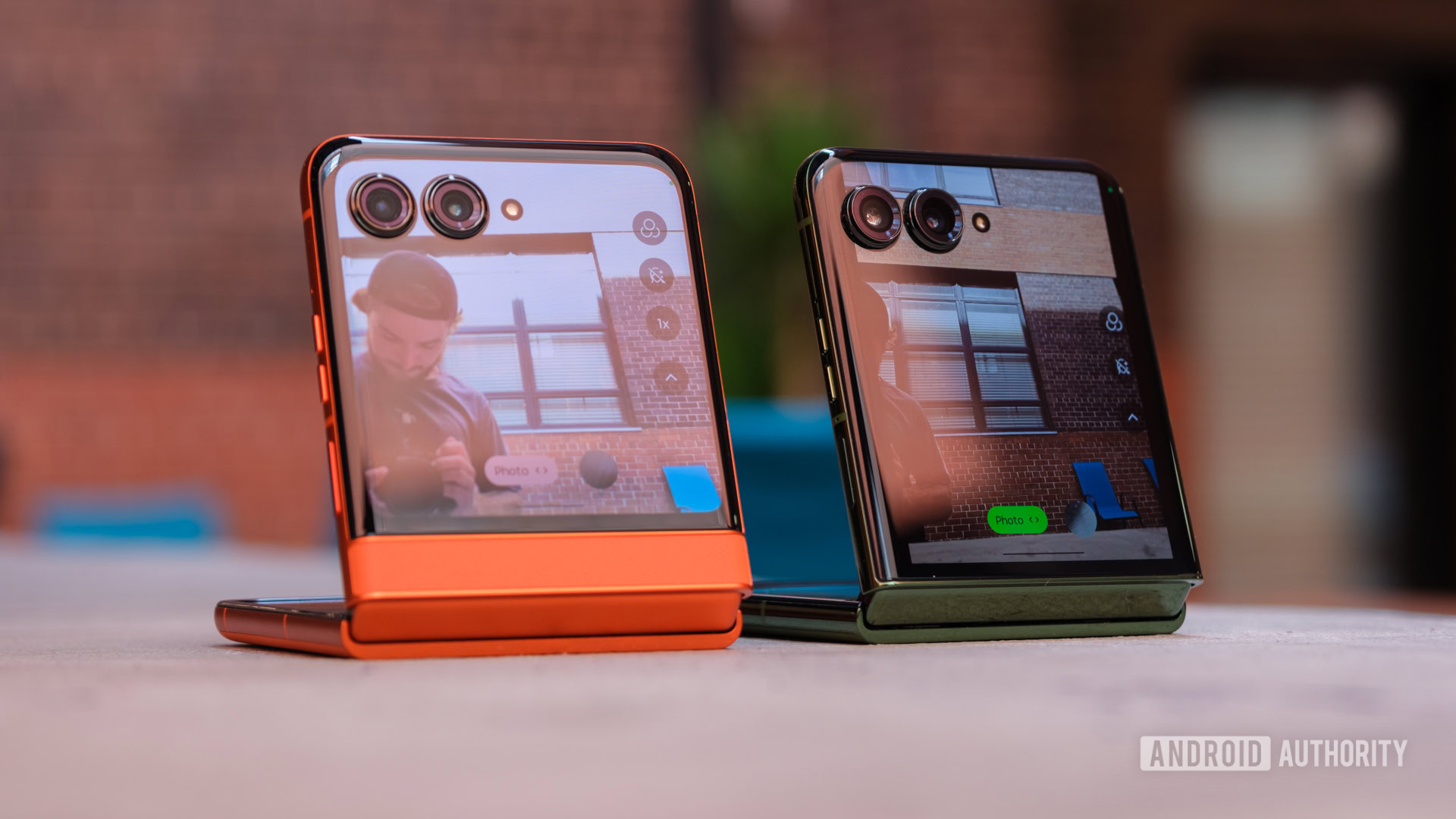
The differences between the camera hardware on the Razr and Razr Plus are among the most surprising reasons I prefer the more budget camera option over the more premium one.
You see, Motorola made one fundamental change to its top-end Razr Plus this year, trading its 12MP ultrawide camera for a 50MP 2x telephoto sensor, and I’m not sure it was the right move while chasing the best camera phones. According to Moto, many of its Razr Plus users were spending more time snapping portraits than taking ultrawide shots, so they decided to replace one with the other. I can’t fault the logic, but you don’t realize how convenient the extra width of an ultrawide camera is until it gets taken away from you.
I never thought I'd miss an ultrawide camera on a phone, until I realized what else it would take away.
I repeatedly found myself staring at a hand-painted advertisement at the Razr launch event in Brooklyn with the Razr Plus (2024) in my hand (I got mine early), cursing that its default 1x mode wasn’t wide enough to capture the entire scene. The same thing happened back home in Baltimore, spotting large sailing ships pulling into the harbor but choosing between capturing the sails or the ship itself in my field of view. The loss of an ultrawide angle also means the loss of Macro Vision on the Razr Plus — a little used but sometimes appreciated feature on a $1,000 flagship device.
Honestly, I never thought that I would be sitting here talking about the fact that I miss an ultrawide camera — by far the least-used sensor on my Google Pixel 8 Pro and Samsung Galaxy S24 Ultra — but I find that I shoot with a flip phone much differently than I shoot with a traditional flagship. It’s easier to flick my wrist twice to open the camera and reach up to capture a shot of myself and my friends, whether at a Baltimore Orioles game, on a run, or trying to beat the heat at a pool. I didn’t have to think about whether the angle would be wide enough on the Razr Plus (2023), nor do I have to worry about it on the Razr (2024), but it’s a key limitation on the Razr Plus (2024). Here are just a few camera samples from both phones:
Motorola Razr
Motorola Razr Plus
You can also view full-size versions of both sets of photos and several others at this Google Drive link.
As for video, the difference in quality is about what you’d expect, with the higher-end Razr Plus offering 4K at up to 60fps on the front and back while the more affordable Razr tops out at 30fps. More importantly, though, Motorola’s simplified Camcorder mode is excellent. Now, it automatically kicks in and begins recording as soon as you fold your Razr to 90 degrees and raise it in front of you — you know, like a camcorder. Then, to stop recording or start a new clip, you tap a large, rectangular button with your thumb. It’s a significant improvement over the 2023 iteration, even if it’s mainly in service of nostalgia.
Pick your TurboPower-ed poison
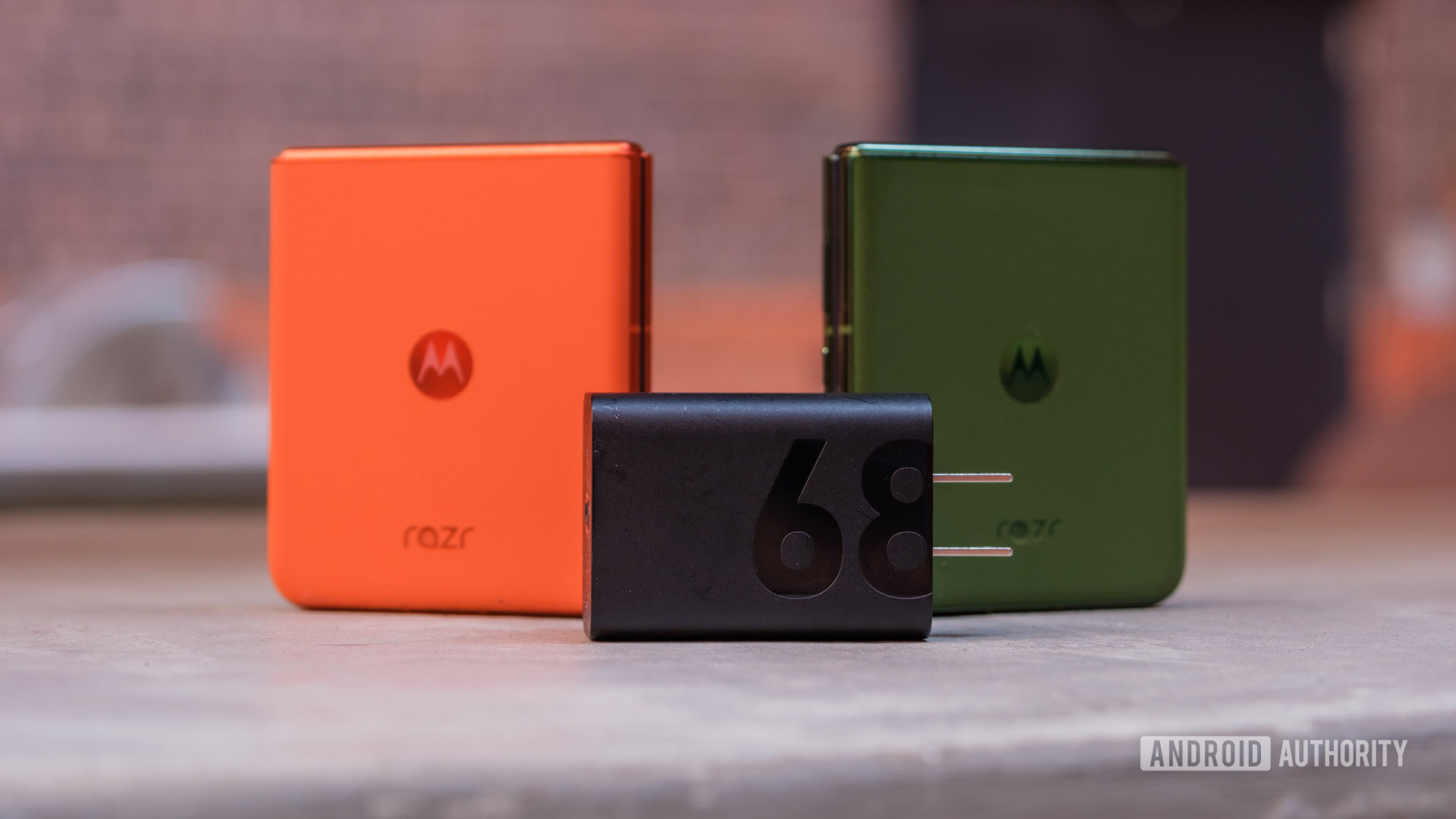
Flip phones are all about how far you can stretch their relatively limited internals. In this case, choosing between the Razr and the Razr Plus comes down to whether you’d rather have faster wired charging and a smaller battery or a larger battery with slower charging options. Once again, I thought I’d prefer one setup, but I’ve been convinced by the other.
Don’t get me wrong, the Razr Plus offers better top-end performance. Its Qualcomm Snapdragon 8s Gen 3 beats the Razr’s MediaTek Dimensity 7300X chipset in almost all of our CPU and GPU benchmarking tests — if you want a flip foldable that can game, the Razr Plus (2024) is your best pick. However, as they say, the candle that burns twice as bright lasts half as long. Unfortunately, the saying is true for the more expensive Razr Plus. The Razr is simply more capable of squeezing the juice out of its larger 4,200mAh cell for longer. Of course, I’d expect it to last longer than the Razr Plus with its 4,000mAh cell, but I wasn’t expecting such a stark difference.
Our standard battery drain test consists of five sections, each of which times how long it takes to drain a phone’s battery by 7%. Then, we blow up the data to see how long a battery would last if it only did that one thing until the phone died. So, I decided to run the Razr and Razr Plus through the gauntlet side by side to see which lasted longer. The phones were neck and neck after the first test — recording a 4K video at 30 frames per second — but then the Razr Plus began to drop like a stone. It burned through video playback, snapping photos with the camera, and web browsing in less than the time the Razr spent on video playback, dropping through its remaining battery at a rate of nearly three to one.
On the bright side, you won’t have to spend as long charging the Razr Plus thanks to its smaller battery and faster 45W TurboPower wired charging. On the other hand, the base Razr tops out at 30W TurboPower wired charging, which still beats the 25W speeds you get on Samsung’s Galaxy Z Flip. Both Razrs also support 15W wireless charging, but only the Razr Plus packs reverse wireless charging, and it’s limited to just 5W. Don’t expect a charger in either box in 2024 — at least not in the US — but thankfully, we can recommend several USB-C wall chargers to keep you topped up at full speed; just make sure they are Power Delivery compatible to get the best results.
Motorola Razr (2024) vs Motorola Razr Plus (2024) specs
| Motorola Razr (2024) | Motorola Razr Plus (2024) | |
|---|---|---|
Display | Motorola Razr (2024) Internal: 6.9-inch LTPO pOLED 2,640 x 1,080 resolution (FHD+) 120Hz refresh rate 413ppi External: 3.6-inch AMOLED 1,056 x 1,066 resolution 120Hz refresh rate 413 ppi | Motorola Razr Plus (2024) Internal: 6.9-inch LTPO pOLED 2,640 x 1,080 resolution (FHD+) 165Hz refresh rate 413ppi External: 4.0-inch AMOLED 1,272 x 1,080 resolution 144Hz refresh rate 417 ppi |
Processor | Motorola Razr (2024) MediaTek Dimension 7300X | Motorola Razr Plus (2024) Snapdragon 8s Gen 3 |
RAM | Motorola Razr (2024) 8GB LPDDR4X | Motorola Razr Plus (2024) 12GB LPDDR5X |
Storage | Motorola Razr (2024) 256GB UFS 2.2 | Motorola Razr Plus (2024) 256GB UFS 4.0 |
Power | Motorola Razr (2024) 4,200mAh battery 30W TurboPower wired charging 15W wireless charging | Motorola Razr Plus (2024) 4,000mAh battery 45W TurboPower wired charging 15W wireless charging 5W reverse wireless charging |
Cameras | Motorola Razr (2024) Rear: - 50MP wide, f/1.7, PDAF, OIS - 13MP ultrawide, f/2.2, 120-degree FoV Selfie: - 32MP wide, f/2.4 | Motorola Razr Plus (2024) Rear: - 50MP wide, f/1.7, PDAF, OIS - 50MP 2x telephoto, f/2.0 Selfie: - 32MP wide, f/2.4 |
Audio | Motorola Razr (2024) Stereo speakers Dolby Atmos Snapdragon Sound 3 microphones | Motorola Razr Plus (2024) Stereo speakers Dolby Atmos Snapdragon Sound 3 microphones |
Video | Motorola Razr (2024) Primary: 4K at 30fps 1080p at 30/60fps Selfie: 4K at 30fps 1080p at 30fps | Motorola Razr Plus (2024) Primary: 4K at 30/60fps 1080p at 30/60fps Selfie: 4K at 30fps 1080p at 30fps |
Durability | Motorola Razr (2024) Vegan leather back Gorilla Glass Victus cover screen Ultra-thin glass display Aluminum frame IPX8 rating | Motorola Razr Plus (2024) Vegan leather back Gorilla Glass Victus cover screen Ultra-thin glass display Aluminum frame IPX8 rating |
Connectivity | Motorola Razr (2024) Wi-Fi 6e Bluetooth 5.4 | Motorola Razr Plus (2024) Wi-Fi 7 Bluetooth 5.4 |
Biometrics | Motorola Razr (2024) Side-mounted fingerprint reader | Motorola Razr Plus (2024) Side-mounted fingerprint reader |
Ports and switches | Motorola Razr (2024) USB 2.0 via USB-C | Motorola Razr Plus (2024) USB 2.0 via USB-C |
Software | Motorola Razr (2024) Android 14 3 full Android updates 4 years of bi-monthly security updates | Motorola Razr Plus (2024) Android 14 3 full Android updates 4 years of bi-monthly security updates |
Dimensions and weight | Motorola Razr (2024) Open: 73.9 x 171.3 x 7.2mm Closed: 73.9 x 88.1 x 15.9mm 188 grams | Motorola Razr Plus (2024) Open: 73.9 x 171.4 x 7.1mm Closed: 73.9 x 88.1 x 15.3mm 189 grams |
Colors | Motorola Razr (2024) Koala Gray Beach Sand Orange Spritz | Motorola Razr Plus (2024) Hot Pink Midnight Blue Peach Fuzz Spring Green |
In the box | Motorola Razr (2024) Motorola Razr (2024) USB-C cable SIM ejector tool Quick start guide | Motorola Razr Plus (2024) Motorola Razr Plus (2024) USB-C cable SIM ejector tool Quick start guide |
Motorola Razr and Razr Plus (2024) review: Which flip phone is worth it?
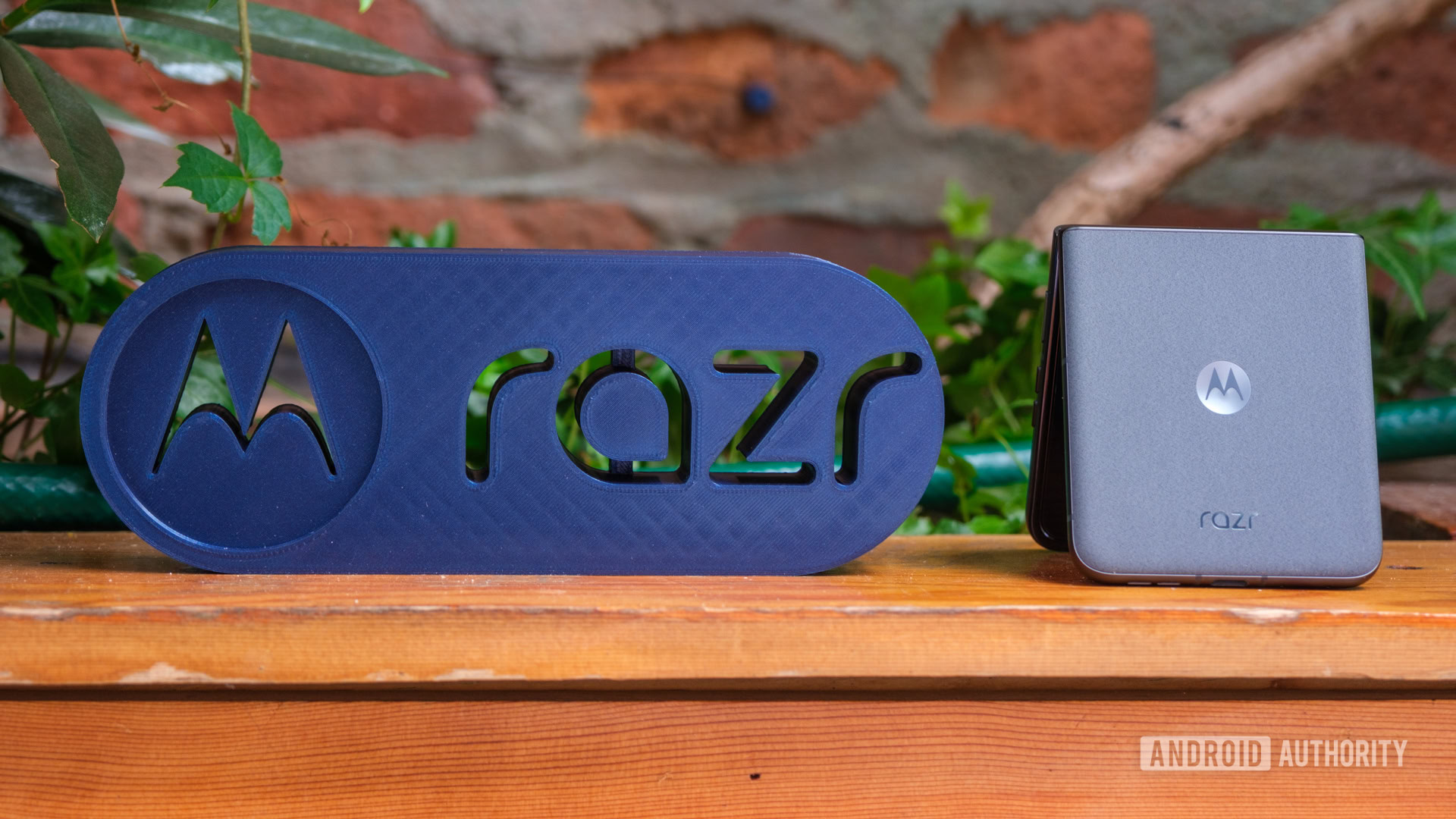
I don’t know about anyone else, but I’ve never had this much trouble choosing between a $1,000 phone and its $700 sibling. I gravitate toward the Pixel 8 Pro over the Pixel 8 or the Galaxy S24 Ultra over the Galaxy S24 because they both offer the same base experience, just with more power behind them and a few flagship extras. This time, I’m not so sure the trade-offs always favor the more expensive option.
Yes, the Motorola Razr Plus (2024) has faster charging. It also has a larger cover screen and a more powerful Snapdragon 8s Gen 3 chipset. All around, it’s a really good flip phone, and it improves on the previous Razr Plus in just about every way. However, the Razr Plus makes a camera swap that I’m not sure works in its favor — especially given its vlog-loving, camcorder-copying camera experience. On top of that, the Razr Plus hasn’t figured out the secret to long-lasting battery life on a flip phone, at least not without using the cover screen for most of the day.
The Razr Plus is a great phone, but is it $300 better than the Razr? I'm not so sure...
On the other hand, the Motorola Razr (2024) puts almost every foot right and does so at a price that’s oh-so-easy to recommend. Although the Dimensity 7300X chipset might not keep up on paper, it’s the biggest blessing to battery life on a folding flip phone I’ve ever used. The base Razr offers so much of last year’s Razr Plus experience that I fell in love with, from the larger cover screen to the widespread Good Lock-free app support to the light, smooth Hello UX experience that almost feels like stock Android, and it does so without the quirks that plagued Motorola’s previous flip phone. If Motorola could beef up its mediocre software update commitment beyond three years of Android support and four years of security patches, any arguments over whether the Razr can match the Galaxy Flip series would be over.
After all, the company has already listened to so much of our previous design feedback. If you remember 2023’s Razr Plus, you’ll remember that its hinge wasn’t quite ready. It loosened over time, suffered from left-to-right wiggle, and never quite opened to 180 degrees. This year is a different story entirely. Motorola’s updated hinge is spot-on, and I’m pretty sure the company is having more fun than any other when it comes to materials. The Razr and Razr Plus come with vibrant hues of vegan leather or vegan suede (which I didn’t know existed) on the back, and the side rails finish the colorful presentations perfectly.
And then, there’s Moto AI. The company is finally jumping into the generative AI race, and it’s setting a different standard for each of its flip phones. Both the Razr and Razr Plus ship with generative wallpaper options like matching your outfit in Style Sync or generating from a text prompt in Magic Canvas, but you’ll need the more premium model for the rest of the bells and whistles. A recent security patch also added Circle to Search to both of Motorola’s Razrs, bringing a nice — but unexpected — boost to the AI flexibility. Only the Razr Plus gets camera tricks like Adaptive Stabilization and Action Shot, and it will eventually pick up features like the ability to summarize your notifications and pick out key information from conversations once Motorola rolls them out — whenever that may be.
Whichever Razr you choose, you're getting an elite foldable flip phone.
With all that out of the way, it certainly sounds like the Motorola Razr (2024) is the best thing since sliced bread, at least if you can live with fewer AI features than rivals like Samsung offer. Either way, the fact is that both the Motorola Razr Plus and the regular ol’ Razr are excellent this year and, in my opinion, have kept pace nicely with Samsung’s Galaxy Z Flip 6, which has barely changed since the Flip 5. As a Razr Plus fanboy, I expected to love Motorola’s top flip phone, but I’m finding the vanilla Razr is far easier to recommend, and I’d dare to call it the best value we’ve seen from a foldable phone available in the US.

Expanded cover displays
Smooth, ad-free software

Bigger battery
Updated cameras